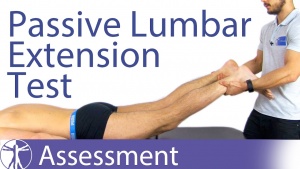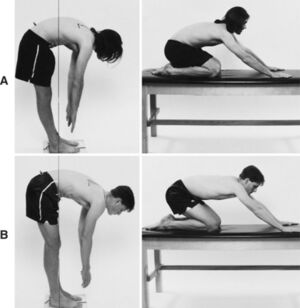Lumbar Spine Range Of Motion: Difference between revisions
No edit summary |
No edit summary |
||
| Line 10: | Line 10: | ||
== Variations ROM Norms == | == Variations ROM Norms == | ||
[[File:Passive lumbar extension test.jpg|right|frameless]] | |||
Variables affect lumbar range of motion: There are significant differences between the motion characteristics of the normal (see table above) and [[Low Back Pain|LBP]] populations. However, due to the diverse nature of these populations, there is great variability within the two groups. This limits the clinical usefulness of these measurements.<ref name=":1">McGregor AH, McCarthy D, Dore CJ, Hughes SP. Quantitative assessment of the motion of the lumbar spine in the low back pain population and the effect of different spinal pathologies on this motion. European Spine Journal. 1997 Sep;6(5):308-15.Available;https://www.ncbi.nlm.nih.gov/pmc/articles/PMC3454599/pdf/586_2005_Article_BF01142676.pdf (accessed 20.11.2022)</ref> | Variables affect lumbar range of motion: There are significant differences between the motion characteristics of the normal (see table above) and [[Low Back Pain|LBP]] populations. However, due to the diverse nature of these populations, there is great variability within the two groups. This limits the clinical usefulness of these measurements.<ref name=":1">McGregor AH, McCarthy D, Dore CJ, Hughes SP. Quantitative assessment of the motion of the lumbar spine in the low back pain population and the effect of different spinal pathologies on this motion. European Spine Journal. 1997 Sep;6(5):308-15.Available;https://www.ncbi.nlm.nih.gov/pmc/articles/PMC3454599/pdf/586_2005_Article_BF01142676.pdf (accessed 20.11.2022)</ref> | ||
| Line 18: | Line 19: | ||
== Validity == | == Validity == | ||
The medical management of LBP patients is based upon clinical history and physical findings, and the measurement of motion forms a core component of assessment. The measurement of motion has the advantage of being more objective and quantifiable than the assessment of subjective measures such as pain. However systematic review concluded there is little evidence to support the use of current methods of range of movement measurement in the lumbar spine. They noted that if ROM is to continue to be to assess spinal function, degree of impairment and response to therapeutic input scientific evidence on the validity of these procedures need be found.<ref>Littlewood C, May S. Measurement of range of movement in the lumbar spine—what methods are valid? A systematic review. Physiotherapy. 2007 Sep 1;93(3):201-11. Available:https://www.csp.org.uk/journal/article/physiotherapy-september-2007/measurement-range-movement-lumbar-spine-what-methods (asccessed 20.11.2022)</ref><ref name=":1" /> | [[File:Testing lumbar flexion.jpg|thumb|Testing Lx Flexion]] | ||
The medical management of LBP patients is based upon clinical history and physical findings, and the measurement of motion forms a core component of assessment. The measurement of motion has the advantage of being more objective and quantifiable than the assessment of subjective measures such as [[Pain Assessment|pain]]. However systematic review concluded there is little evidence to support the use of current methods of range of movement measurement in the lumbar spine. They noted that if ROM is to continue to be to assess spinal function, degree of impairment and response to therapeutic input scientific evidence on the validity of these procedures need be found.<ref>Littlewood C, May S. Measurement of range of movement in the lumbar spine—what methods are valid? A systematic review. Physiotherapy. 2007 Sep 1;93(3):201-11. Available:https://www.csp.org.uk/journal/article/physiotherapy-september-2007/measurement-range-movement-lumbar-spine-what-methods (asccessed 20.11.2022)</ref><ref name=":1" /> | |||
== Methods Available == | == Methods Available == | ||
| Line 27: | Line 29: | ||
* Inclinometer: an advanced expensive equipment for measurement of ROM. An inclinometer is a handheld, circular, fluid-filled disc that has a weighted gravity pendulum attached to it that is maintained in the vertical direction. It is graduated by 0.5 degree intervals over 360 degrees.<ref name=":0" /> | * Inclinometer: an advanced expensive equipment for measurement of ROM. An inclinometer is a handheld, circular, fluid-filled disc that has a weighted gravity pendulum attached to it that is maintained in the vertical direction. It is graduated by 0.5 degree intervals over 360 degrees.<ref name=":0" /> | ||
* [[Goniometer]] | * [[Goniometer]] | ||
* Tapemeasure | |||
== References == | == References == | ||
<references /> | <references /> | ||
Revision as of 09:48, 20 November 2022
Original Editor - Lucinda hampton
Top Contributors - Lucinda hampton, Kim Jackson and Aminat Abolade
Introduction[edit | edit source]
Assessment of range of motion (ROM) of the lumbar spine is an important part lumbar spine examination. Aberrant spinal motion is associated with faulty spinal mechanics. Motion of the lumbar spine is assessed in all planes including flexion, extension, side bending, and rotation.
Variations ROM Norms[edit | edit source]
Variables affect lumbar range of motion: There are significant differences between the motion characteristics of the normal (see table above) and LBP populations. However, due to the diverse nature of these populations, there is great variability within the two groups. This limits the clinical usefulness of these measurements.[2]
- Flexion (73-40 degrees) declines noted with age.
- Lateral flexion (28-14 degrees, L&R) declined with age.
- Extension (29-6 degrees) declined the greatest at 79% with age.
- No decline in axial rotational (7%) way across the age spectrum. [3]
Validity[edit | edit source]
The medical management of LBP patients is based upon clinical history and physical findings, and the measurement of motion forms a core component of assessment. The measurement of motion has the advantage of being more objective and quantifiable than the assessment of subjective measures such as pain. However systematic review concluded there is little evidence to support the use of current methods of range of movement measurement in the lumbar spine. They noted that if ROM is to continue to be to assess spinal function, degree of impairment and response to therapeutic input scientific evidence on the validity of these procedures need be found.[4][2]
Methods Available[edit | edit source]
The most accurate method to measure the movement of the vertebrae is through radiography, but use of long-term radiography is not sensible due to risk of radiation and cost.[1]Other methods of measurement include:
- Fingertip to floor test
- Schober test and modified Schober test
- Inclinometer: an advanced expensive equipment for measurement of ROM. An inclinometer is a handheld, circular, fluid-filled disc that has a weighted gravity pendulum attached to it that is maintained in the vertical direction. It is graduated by 0.5 degree intervals over 360 degrees.[1]
- Goniometer
- Tapemeasure
References[edit | edit source]
- ↑ 1.0 1.1 1.2 Musculoskeletal Key Physical Examination of the Lumbar Spine Available: https://musculoskeletalkey.com/physical-examination-of-the-lumbar-spine/ (acessed 20.11.2022)
- ↑ 2.0 2.1 McGregor AH, McCarthy D, Dore CJ, Hughes SP. Quantitative assessment of the motion of the lumbar spine in the low back pain population and the effect of different spinal pathologies on this motion. European Spine Journal. 1997 Sep;6(5):308-15.Available;https://www.ncbi.nlm.nih.gov/pmc/articles/PMC3454599/pdf/586_2005_Article_BF01142676.pdf (accessed 20.11.2022)
- ↑ Troke M, Moore AP, Maillardet FJ, Cheek E. A normative database of lumbar spine ranges of motion. Manual therapy. 2005 Aug 1;10(3):198-206.Available:https://pubmed.ncbi.nlm.nih.gov/16038855/ (accessed 20.11.2022)
- ↑ Littlewood C, May S. Measurement of range of movement in the lumbar spine—what methods are valid? A systematic review. Physiotherapy. 2007 Sep 1;93(3):201-11. Available:https://www.csp.org.uk/journal/article/physiotherapy-september-2007/measurement-range-movement-lumbar-spine-what-methods (asccessed 20.11.2022)









